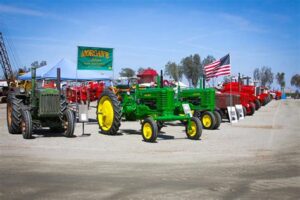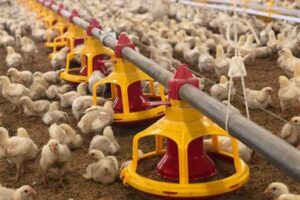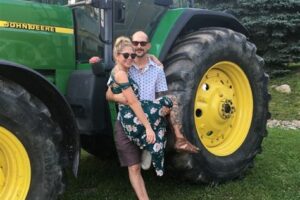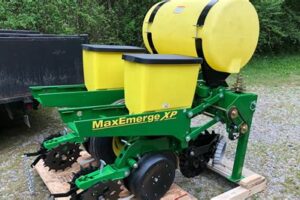Table of Contents
Learn about the different types of farm equipment used in modern agriculture. Discover the various machines and tools that help farmers with planting, harvesting, irrigation, and livestock management. From tractors and combines to balers and sprayers, explore the essential equipment that plays a crucial role in enhancing farming efficiency and productivity.
When it comes to modern agriculture, having the right farm equipment is essential for optimizing production and efficiency. From tractors to harvesters, there is a wide array of machinery available to cater to the diverse needs of farmers. Whether you have a small-scale farm or a large commercial operation, understanding the different types of farm equipment can significantly impact your ability to cultivate crops, manage livestock, and streamline operations. In this article, we will explore some of the most common types of farm equipment, highlighting their key features and benefits.
Introduction
Farming is a crucial industry that requires specialized equipment to ensure efficiency and productivity. From planting to harvesting, there are various types of farm equipment designed to aid farmers in their daily tasks. These machines have revolutionized agriculture by reducing manual labor and increasing output. In this article, we will explore some of the most common types of farm equipment used worldwide.
Tractors
Definition and Function
Tractors are versatile machines that are essential for any farming operation. They are primarily used for pulling or pushing heavy loads, such as plows or trailers. Tractors come in different sizes and power capacities, allowing farmers to choose the right model based on their needs.
Types of Tractors
There are several types of tractors, including utility tractors, row-crop tractors, orchard tractors, and garden tractors. Each type is designed for specific agricultural tasks, such as tilling, spraying, or mowing.
Combine Harvesters
Definition and Function
Combine harvesters, also known as combine machines or harvesters, are used to harvest crops like wheat, corn, and soybeans. These machines combine the processes of cutting, threshing, and cleaning the harvested crops in one operation.
Components of a Combine Harvester
A typical combine harvester consists of a cutting platform, threshing drum, straw walker, grain tank, and cleaning system. The cutting platform cuts the crops, while the threshing drum separates the grain from the plant. The straw walker then shakes the remaining straw, allowing any remaining grain to fall into the grain tank.
Seeders and Planters
Definition and Function
Seeders and planters are farm equipment used for planting seeds in the soil. They help ensure accurate seed placement and improve planting efficiency.
Differences Between Seeders and Planters
Seeders are machines that distribute seeds uniformly across a field, while planters place individual seeds at precise intervals and depths. Seeders are commonly used for large-scale planting, while planters are suitable for smaller areas or when specific plant spacing is required.
Sprayers
Definition and Function
Sprayers, as the name suggests, are used to apply fertilizers, pesticides, or herbicides to crops. They are essential for protecting plants from pests, diseases, and weeds.
Types of Sprayers
There are various types of sprayers, including boom sprayers, air-assisted sprayers, and handheld sprayers. Boom sprayers are commonly used for large fields, while handheld sprayers are suitable for smaller areas or spot treatments.
Balers
Definition and Function
Balers are machines used to compress and bundle crops, such as hay or straw, into compact and manageable bales. These bales are easier to store, transport, and feed to livestock.
Types of Balers
There are two main types of balers: round balers and square balers. Round balers produce cylindrical-shaped bales, while square balers create rectangular bales. The choice between the two depends on the farmer’s preference and the intended use of the bales.
Harrows
Definition and Function
Harrows are farm implements used to break up and smooth the soil after plowing, leveling the field, and preparing it for planting. They help improve soil aeration, remove weeds, and create a suitable seedbed.
Types of Harrows
There are various types of harrows, including disc harrows, chain harrows, and tine harrows. Disc harrows use rotating discs to break up the soil, while chain and tine harrows use chains or teeth to level the ground.
Spreaders
Definition and Function
Spreaders, also known as fertilizer spreaders, are used to evenly distribute fertilizers, lime, or seeds across a field. They help improve soil fertility and ensure uniform plant growth.
Types of Spreaders
The two main types of spreaders are broadcast spreaders and drop spreaders. Broadcast spreaders distribute materials in a wide pattern, while drop spreaders release them in a precise path. The choice depends on the size of the area to be covered and the desired spread width.
Irrigation Systems
Definition and Function
Irrigation systems are essential for providing water to crops when natural rainfall is insufficient. They help maintain optimal soil moisture levels, ensuring healthy plant growth and maximizing yield.
Types of Irrigation Systems
There are several types of irrigation systems, including sprinkler irrigation, drip irrigation, and center pivot irrigation. Sprinkler irrigation uses overhead sprinklers to distribute water, drip irrigation delivers water directly to the plant roots, and center pivot irrigation rotates around a central pivot point, covering a large circular area.
Conclusion
Farm equipment plays a vital role in modern agriculture, enabling farmers to efficiently perform various tasks. Tractors, combine harvesters, seeders, sprayers, balers, harrows, spreaders, and irrigation systems are just a few examples of the many types of farm equipment available. By utilizing these machines, farmers can increase productivity, reduce labor, and ultimately contribute to the world’s food production.
Types of Farm Equipment
Farming is a demanding and labor-intensive industry that requires the use of various types of equipment to maximize productivity and efficiency. From tractors to cultivators, each piece of farm equipment serves a specific purpose and plays a crucial role in modern agricultural practices. In this article, we will explore some of the most commonly used types of farm equipment and their importance in the farming industry.
Tractors
Tractors are the backbone of any farm operation. These powerful machines are equipped with engines and durable tires designed to handle a wide range of tasks such as plowing, planting, cultivating, and harvesting. Tractors come in different sizes and configurations to accommodate various farming needs. They are highly versatile and can be equipped with numerous attachments and implements, including plows, seeders, cultivators, and harvesters, to maximize their functionality. Tractors are indispensable for farmers as they significantly reduce manual labor and improve overall efficiency.
Harvesters
Harvesting crops is one of the most labor-intensive and time-consuming tasks on a farm, especially on large-scale operations. Harvesters are specialized machines designed to simplify and streamline the process of cutting, separating, and collecting crops such as cereals, fruits, vegetables, and grains. These machines significantly reduce the amount of manual labor required for harvesting, thereby increasing overall productivity. Harvesters come in various types, including combine harvesters, fruit pickers, and rice harvesters, each designed to cater to specific crop types and farm sizes.
Planters
Efficient and accurate sowing of seeds is essential for optimal crop growth and yield. Planters are farm machines equipped with mechanisms that ensure precise spacing and depth for seed placement. Modern planters feature advanced technologies like GPS guidance systems, which enable farmers to achieve higher precision and make better use of available land. Planters play a crucial role in maximizing crop productivity by ensuring uniform seed distribution and reducing the risk of overcrowding or underplanting.
Sprayers
Controlling pests, diseases, and weeds is vital for maintaining crop health and maximizing yields. Sprayers are farm machines designed to apply fertilizers, pesticides, and herbicides evenly and precisely to crops. These machines offer adjustable spraying capabilities, reducing chemical wastage and ensuring even coverage. Sprayers help farmers minimize the environmental impact of their operations by targeting specific areas that require treatment, rather than blanket application. They also contribute to improved crop quality and reduced crop loss due to pest or disease infestations.
Irrigation Systems
Water is essential for healthy crop growth and yield. Irrigation systems are farm equipment used to provide a controlled water supply to crops. Various irrigation methods, such as sprinklers, drip irrigation, and center pivots, are used depending on factors such as farm size, water availability, and crop requirements. These systems significantly reduce water wastage by delivering water directly to the crop roots, minimizing evaporation and runoff. Irrigation systems enable farmers to optimize water usage and ensure that crops receive the right amount of water at the right time.
Balers
Baling hay, straw, or other crop residues is essential for easy storage, transportation, and feeding livestock. Balers are farm machines used to compress and bind these materials into bales. They contribute to efficient farm management by reducing bulkiness and improving handling capabilities. Balers come in different sizes and types, including round, square, and rectangular, to cater to various farm needs. They play a vital role in ensuring the availability of high-quality feed for livestock throughout the year.
Spreaders
Fertilizers, manure, lime, and other soil amendments are crucial for maintaining soil fertility and promoting healthy crop growth. Spreaders are farm machines used to evenly distribute these materials onto fields. They come in different configurations like broadcast spreaders, drop spreaders, and pendulum spreaders to suit different materials and application areas. Spreaders ensure uniform nutrient distribution, minimizing the risk of nutrient deficiencies and promoting optimal crop growth. By efficiently spreading soil amendments, farmers can maximize the effectiveness of their inputs and reduce costs.
Cultivators
Preparing the soil before planting crops is essential for optimal root development and weed control. Cultivators are farm machines designed to loosen and aerate the soil, remove weeds, and incorporate organic matter. They come in various designs, such as tillers, shovels, and sweep cultivators, allowing farmers to choose the most suitable tool based on soil conditions and the type of cultivation required for specific crops. Cultivators play a crucial role in creating an ideal seedbed, promoting healthy crop growth, and maximizing yields.
In conclusion, the use of various types of farm equipment is essential for modern agricultural practices. Tractors, harvesters, planters, sprayers, irrigation systems, balers, spreaders, and cultivators each serve specific purposes and contribute to increased productivity, efficiency, and profitability on farms. By investing in and utilizing the right farm equipment, farmers can optimize their operations, improve crop quality and yield, and ensure sustainable and profitable farming practices.
When it comes to farming, having the right equipment is essential for maximizing productivity and efficiency. The advancements in technology have revolutionized the agricultural sector, providing farmers with a wide range of equipment options to choose from. In this article, we will discuss the various types of farm equipment that are commonly used today.
1. Tractors:
- Tractors are the backbone of any farming operation, as they are versatile machines that can perform a variety of tasks.
- They are used for plowing, planting, harvesting, and hauling heavy loads.
- Tractors come in different sizes and horsepower capabilities, allowing farmers to choose the one that best suits their specific needs.
2. Harvesters:
- Harvesters are specialized machines designed to efficiently and quickly harvest crops such as wheat, corn, and soybeans.
- They are equipped with cutting mechanisms that remove the crop from the ground and separate the grain from the plant.
- Modern harvesters also come with features like GPS navigation systems and yield monitoring, which help farmers optimize their harvest.
3. Planters and Seeders:
- Planters and seeders are used to sow seeds into the ground, ensuring proper spacing and depth for optimal growth.
- These machines save significant time and labor compared to manual planting, especially for large-scale farming operations.
- Some advanced planters and seeders are equipped with technologies that allow farmers to precisely control the amount of seed being planted, resulting in better yield and cost savings.
4. Sprayers:
- Sprayers are crucial for pest and weed control, as they allow farmers to efficiently apply herbicides, insecticides, and fungicides to their crops.
- They come in various designs, including tractor-mounted, self-propelled, and handheld options.
- Modern sprayers are equipped with advanced technologies like GPS guidance and variable rate application, which enable precise and targeted spraying, minimizing chemical use and reducing environmental impact.
5. Balers:
- Balers are used to compress and package crops like hay or straw into compact bales for transportation and storage.
- They come in different sizes and designs, including round balers and square balers.
- Balers greatly facilitate the handling and storage of bulky crops, making them more manageable and marketable.
6. Irrigation Systems:
- Irrigation systems are essential for providing water to crops, especially in areas with limited rainfall or during dry seasons.
- They help maintain optimal soil moisture levels, promoting healthy plant growth and maximizing yield.
- There are various types of irrigation systems available, including sprinkler systems, drip irrigation, and center pivot systems, each with its own advantages depending on the farm’s needs and resources.
In conclusion, having the right farm equipment is crucial for the success of any farming operation. Tractors, harvesters, planters and seeders, sprayers, balers, and irrigation systems are just a few examples of the wide array of equipment available to modern farmers. Investing in the right equipment can significantly improve productivity, efficiency, and profitability, enabling farmers to meet the growing demands of the agricultural industry.
Thank you for taking the time to visit our blog and explore the fascinating world of farm equipment. We hope that this article has provided you with valuable insights into the different types of machinery used in modern farming. As you have seen, these tools are essential for enhancing productivity, efficiency, and sustainability in agricultural practices.
Throughout this article, we have discussed several categories of farm equipment, each serving a unique purpose on the farm. From tractors and combines to tillage and planting machinery, these tools play a crucial role in various aspects of farming operations. By understanding their functionalities and benefits, farmers can make informed decisions about the equipment they need to invest in for their specific needs.
It is important to note that the field of farm equipment is constantly evolving and adapting to the changing needs of the industry. New technologies and innovations continue to revolutionize the way farmers work, enabling them to achieve higher yields and better outcomes. As you delve deeper into the world of agriculture, we encourage you to stay updated with the latest advancements in farm equipment, as they can greatly impact the success and profitability of your farming endeavors.
In conclusion, the diverse range of farm equipment available today plays a vital role in modern agriculture. These tools not only make farming more efficient but also contribute to sustainable practices that benefit both the environment and the economy. We hope that this article has helped you gain a better understanding of the different types of farm equipment and their significance in the agricultural sector. Should you have any further questions or require additional information, please do not hesitate to reach out to us. Happy farming!
.
Types of Farm Equipment
When it comes to agricultural activities, having the right farm equipment can make a significant difference in productivity and efficiency. Here are some common questions people ask about different types of farm equipment:
What are the essential types of farm equipment?
There are several essential types of farm equipment that every farmer should consider having:
- Tractors: Tractors are versatile machines used for various tasks such as plowing, tilling, planting, and harvesting.
- Harvesters: Harvesters are specialized machines designed to efficiently gather crops like wheat, corn, or rice.
- Planters and Seeders: These machines are used to sow seeds and plant crops evenly and accurately.
- Sprayers: Sprayers are used to apply pesticides, herbicides, and fertilizers to crops.
- Hay Balers: Hay balers are utilized to compress and bundle hay into manageable bales.
- Combine Harvesters: Combine harvesters perform the tasks of cutting, threshing, and cleaning grain crops in a single operation.
What are the different types of tractors used in farming?
Tractors come in various types, each suitable for specific farming tasks:
- Utility Tractors: Versatile tractors used for general-purpose farming activities like plowing or hauling.
- Row Crop Tractors: Designed to navigate row crops without damaging the plants.
- Orchard Tractors: Compact tractors specially designed for use in orchards and vineyards.
- Sub-Compact Tractors: Smaller tractors used for lighter tasks or in small-scale farming operations.
- Industrial Tractors: Heavy-duty tractors used for industrial or commercial farming applications.
What are some common types of harvesting equipment?
Harvesting equipment varies depending on the crop being harvested. Some common types include:
- Combine Harvesters: These machines are widely used for harvesting grain crops like wheat, barley, or corn.
- Potato Harvesters: Specifically designed to harvest potatoes efficiently, minimizing damage to the crop.
- Cotton Pickers: Automated machines that effectively pick cotton from plants, reducing manual labor requirements.
- Forage Harvesters: Used to harvest forage crops such as corn silage or alfalfa.
- Fruit Harvesters: Specialized machines for harvesting fruits, including apples, oranges, or berries.
Which equipment is commonly used for irrigation?
Irrigation is crucial for maintaining healthy crops. The following equipment is commonly used for irrigation:
- Sprinkler Systems: Sprinkler systems distribute water over a large area, mimicking rainfall.
- Drip Irrigation: Drip irrigation provides water directly to the roots of plants, conserving water and reducing weed growth.
- Pivots: Center pivot irrigation systems rotate around a central point, irrigating circular areas of farmland.
- Reel Irrigation: This system uses a large reel to unwind a flexible water hose, irrigating as it moves across the field.
Having the right farm equipment can significantly enhance productivity and efficiency on the farm. Whether it’s tractors, harvesters, or irrigation systems, choosing the appropriate equipment for specific farming tasks is essential for success.






